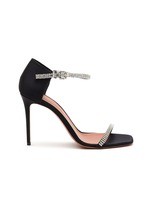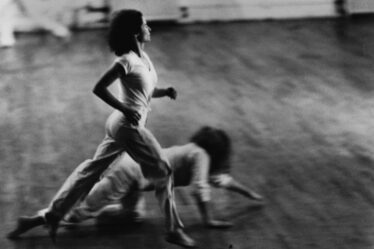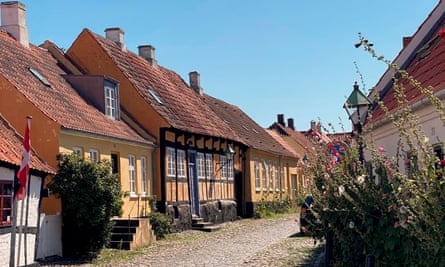
The Swedes, with their lush forests, and the Norwegians, with their dramatic mountains, like to joke about Denmark – that it is Scandinavia’s leftovers all squeezed together and flattened by the ice age … some punchline. But part of the big attraction of Denmark and its people comes through their philosophy of respect for nature and their abundance of hygge, in the main being happy for others and letting them just be.
On a broad bay in the country’s Djursland peninsula sits the pretty coastal town of Ebeltoft, surrounded by the green hills and bronze age burial mounds of the Mols Bjerge national park. All cobbled streets and creaking half-timbered houses painted in lovely pastel shades, it buzzes with families on a long weekend break. There are opportunities for days splashing in the cool waters of the Baltic sea, windy walks on the harbour, visiting tall Viking ships and taking cycle rides along the many signposted paths. It is picture perfect holiday fodder.
But just on the outskirts of this impeccably charming Danish town is another, little-known tourist attraction. Sitting off a busy main road is the sustainable community of Friland, an eco-community where all the inhabitants have built their own homes with the hope of living mortgage-free. The idea started as a Big Brother-esque experiment on Denmark’s national television station DR-TV two decades ago. It featured 13 families who left behind their busy lives and transformed a small village with back-to-basics living as the prerequisite.
The reality is that not all the residents stayed – some were unable to finish their homes, others no longer wanted to be part of the experiment – but many thrived. Houses were made of straw bales, wooden planks and other natural and recyclable materials such as seashells and sawdust, and the programme was a hit. Long after the cameras left, the community continued to grow and it has now become a blueprint for cooperative, simple living.
About 2,000 tourists visit every year, with guided tours conducted by residents from May to October showing how the 45 families live. One of the residents who conducts these tours is Nikolai, 44, a former boarding school teacher who moved into the community five years ago with his family. He is building a home inspired by African architecture – organic and playful, it has a beech tree running through its centre and will be painted with a lime and yoghurt mix instead of render.
“I became interested in the idea about 10 years ago – the thought of building my own home, living sustainably and without a mortgage was a dream for us,” says Nikolai. “It has given us a quality of life that we never thought we could have and we want to share that with others, to show them that it is something everyone can achieve.”
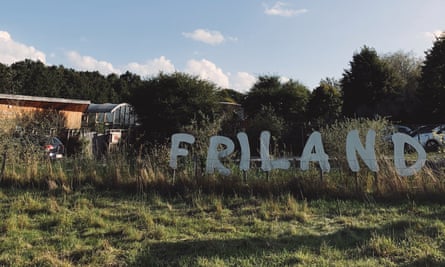
The caveat for living in the community is that residents cannot have a mortgage so need to save the money to build their own home. One man lived in a caravan for 13 years before building his home and others have come up with innovative ideas to build on minuscule budgets – including a home in the community which is fully insulated with wine corks. The residents make a living in a variety of interesting ways. One couple started a permaculture – or sustainably high yield farm- on the site with other residents paying them to grow produce. There are ceramicists, joiners, embroiderers – all of whom sell their goods.
“In every family there is usually one person who is making something or running a business,” says Nikolai. “It is between a collective and a village – we all have a skill that we can then share.”
It is inspiring. This is Grand Designs but without the cash and fanfare, with a common, shared goal at its heart – mainly to live without debt, but also to create a way of living that has very little impact on the environment and that brings people together. There is a volunteer-based grocery store and cafe on site; a shed containing clothes which are free; and the community hold an evening once a month where they all eat together. There is also an annual general assembly meeting where residents decide on projects they might want to initiate for the following year. All perfect ingredients for a more sustainable lifestyle.
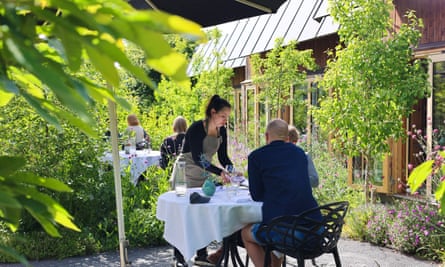
Somewhat surprisingly there is a fine dining eatery, Restaurant Moment, at the entrance to the village. Run by former residents Rikke and Morten Storm Overgaard, the restaurant is featured in the Michelin guide with its well-heeled clientele paying up to £200 (including drinks) for the tasting menu.
You might wonder if the presence of this restaurant jars. But the couple lived in the community for nine years and somehow it fits. The ethos is the same as the community, albeit on a slightly pricier scale.
The two did not have a background in food – Rikke worked in geology and Morten is a professor in cognitive neuroscience – but their approach to the restaurant wasn’t really about creating haute cuisine, it was more about tackling the “biggest problems” the world faces with the climate and biodiversity.
after newsletter promotion
“All we were doing was complaining about politicians and remembering to buy organic lemons in the supermarket – I mean, it felt like doing nothing,” says Morten. “So we thought how do we go about making a real impact and we decided to do something I guess that was crazy at the time – we turned a parking lot into a restaurant.”
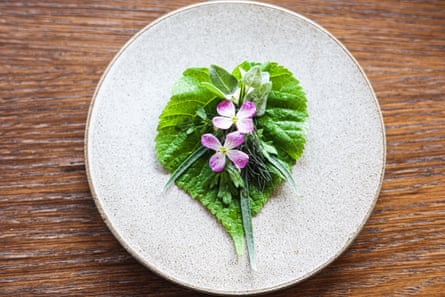
After touring Friland, we head to Moment for a meal. It is a shift in gears – serene surroundings and clean edges with a plant-based menu paired with natural wines and homemade fermented juices for the children. There are beets that lie on a bed of hollandaise sauce with a base of miso topped with a tuile of coffee gel and mirabelle flowers from the garden; carrots that have been fermented, pickled and burned, separated by leaves of orpine with a spruce tip emulsion; buckwheat, and sour cream split with wild onion oil; another dish of asparagus served with pickled sea sandwort, flowers and beurre blanc. And the hand-glazed dishes just keep coming – each one as impossibly delicate and beautiful as the next.
We are in awe of what the couple have created. Just a few years ago, outside its picture windows, where there is now a large greenhouse and a well-stocked garden, there was a car park. Rikke and Morten spent years cultivating the land, and the gardens now provide many of the ingredients for the restaurant’s dishes. There are solar panels for electricity, rainwater is used in the greenhouse and there’s a clever off-grid internal heating system.
When I eventually leave the restaurant and Friland, I reflect on how they share a common goal of self-reliance and the protection of our increasingly delicate environment.
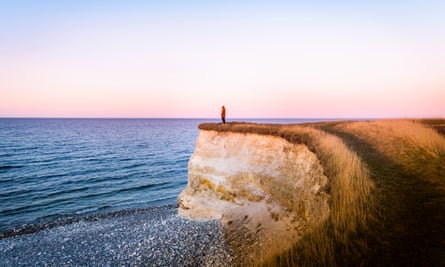
The experience leads to a conversation later in the holiday about which are the “happiest” countries and a quick Google search confirms my instincts – Denmark is second in the 2023 World Happiness Report.
As we head to our hotel, Langhoff and Juul (family rooms from £241), we track Ebeltoft bay and clock the wooden clad, achingly cool summerhouses – seemingly competing for the best spot and smartest finish. We learn that many Danes like to have a summerhouse property for their own domestic holidays and to rent out to tourists … and resolve to start saving up.
Throughout the break, we find an emphasis on nature, cycling, watersports and other outdoor family-friendly activities complemented by the pristine coastline around the Djursland region, populated by a content, welcoming people.
The trip was provided by Visit Denmark

